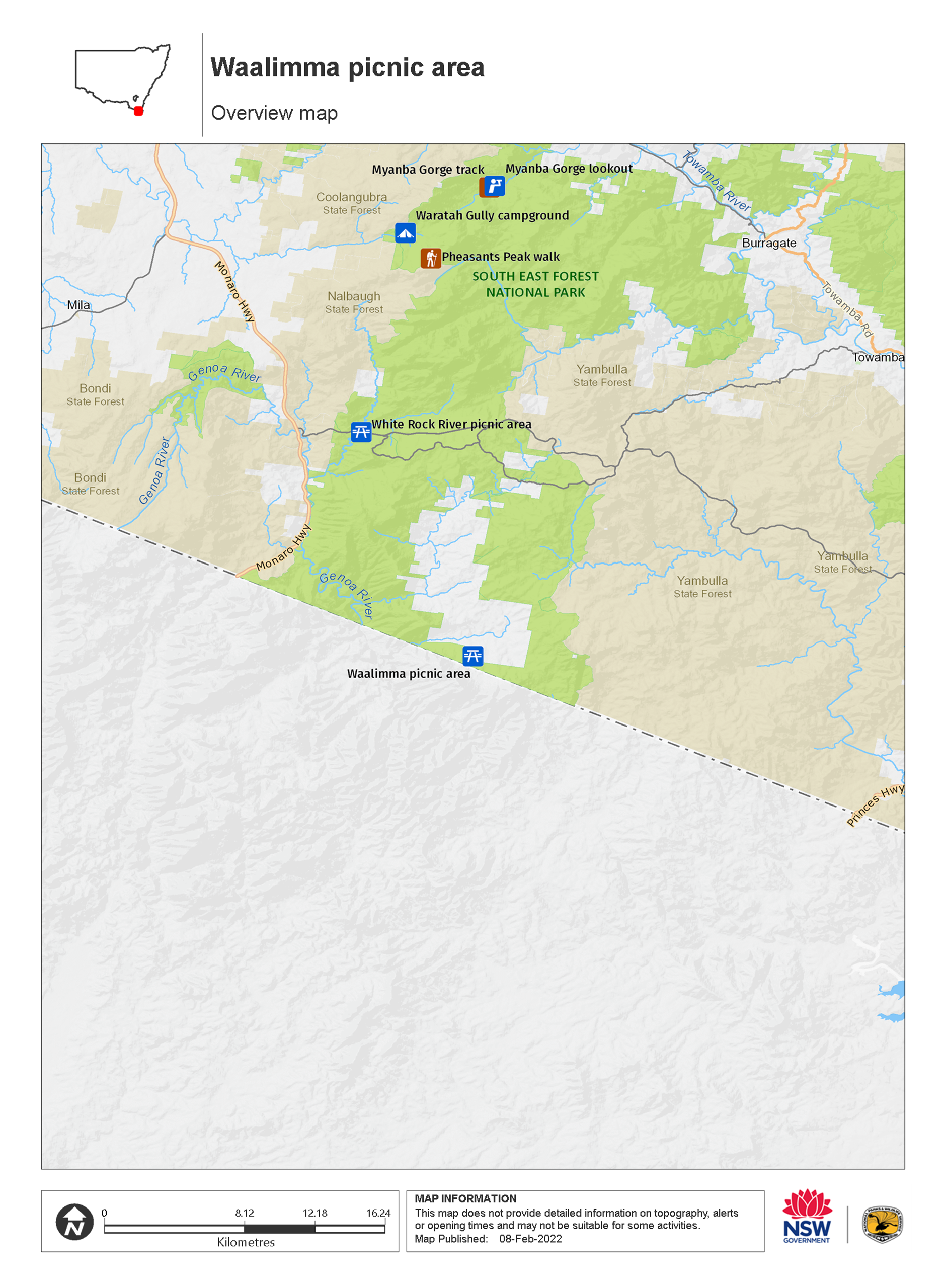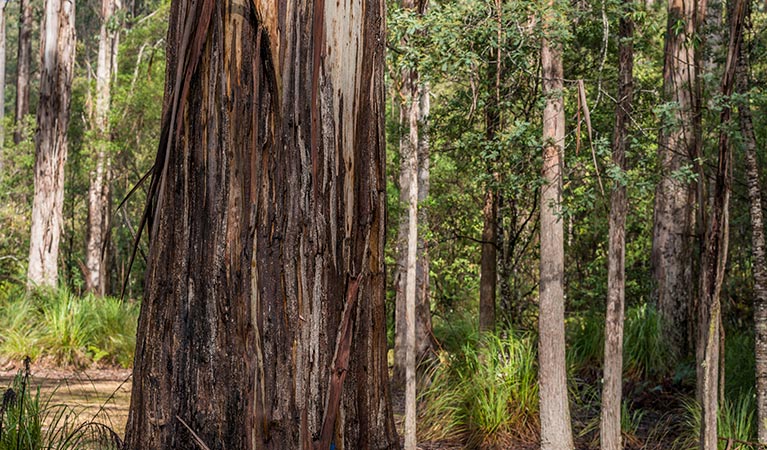Waalimma picnic area
South East Forest National Park
Overview
Located near both Bega and Bombala on the NSW south coast, Waalimma picnic area in South East Forest National Park is great for birdwatching, bushwalking and camping.
- Type
- Picnic areas
- What to
bring - Hat, sunscreen, drinking water
- Please note
- The sandy beaches along the Genoa River provide excellent places to set up camp but be vigilant because if it rains heavily and you’re camped close to the water’s edge, the river can rise rapidly.
- The weather in this area can be extreme and unpredictable, so please ensure you’re well prepared for your visit.
- Remember to take your binoculars if you want to go birdwatching.
The beautifully secluded Waalimma picnic area is a fantastic place to pause before or after completing a walk into the Genoa wilderness.
Located near the Waalimma campground, fringed by red box eucalyptus, this great picnic spot is equipped with fire rings, picnic tables and an education and visitor centre.
This remote part of South East Forest National Park, characterised by impressive Devonian geology with sheer cliffs, large waterholes and sandy beaches, is beloved by experienced, self-reliant bushwalkers.
Venture down here with some goodies to munch and be immersed in the beauty and tranquillity of your surroundings. As well as picnicking and beginning a hike from this serene vantage point, you can head out for a river swim, go exploring or rock-hopping, or indulge in a spot of birdwatching.
Listen at night to the conversation of nocturnal birds, including sooty owls and southern boobooks, known as ‘mopokes’, and keep an eye out for more emblematic Aussie wildlife. Wallabies, dingoes, emus and wombats are part of this bush neighbourhood, along with lizards, snakes and possums.
Many walks to and from Waalimma picnic area involve on-foot river crossings, so visit in the warmer weather of summer, early autumn or late spring to avoid an icy-cold dip.
Map

Map legend

Local alerts
For the latest updates on fires, closures and other alerts in this area, see https://www.nationalparks.nsw.gov.au/things-to-do/picnic-areas/waalimma-picnic-area/local-alerts
General enquiries
- National Parks Contact Centre
- 7am to 7pm daily
- 1300 072 757 (13000 PARKS) for the cost of a local call within Australia excluding mobiles
- parks.info@environment.nsw.gov.au
Park info
- in South East Forest National Park in the South Coast and Snowy Mountains regions
South East Forest National Park is always open but may have to close at times due to poor weather or fire danger.
Visitor info
All the practical information you need to know about the Waalimma picnic area.
Maps and downloads
Learn more
Waalimma picnic area is in South East Forest National Park. Here are just some of the reasons why this park is special:
Ancient connections

South East Forest National Park is part of the traditional country of the Yuin People, who had a diverse economy and cultural links with neighbouring Aboriginal clans and tribes. South East Forest National Park and the surrounding area provided a diverse food source of animals and fish, a rich resource for weapon and tool construction, as well as a source of medicines and transport. The park protects a number of Aboriginal sites and remains an important landscape for Aboriginal people today.
Old-growth

In the early 19th century, explorers, miners, squatters and timber getters led the way into the area that is now South East Forest National Park. The forests within the park were utilised as resources for many years up until the 1980's when their transition to national park commenced. The old-growth forest contains eucalypt trees in their final cycle of growth; trees that provide many different types of nest or home sites for wildlife. Some animals, like large forest owls and glider possums depend on these forests for hollows that develop over long periods of time. Pipers lookout in the northern part of the park is a good place to see old growth forests. Take the short loop walk to see magnificent views of Bemboka and the Bega Valley below, and walk through towering old growth forest.
Rock on

South East Forest National Park protects unique physical features that are sure to appeal to budding geologists, keen photographers and nature-lovers alike. The huge granite tors at Pheasants Peak are the result of volcanic activity and millions of years of weathering and erosion. For a close up view, take the challenging Pheasants Peak walk, you'll also be rewarded with stunning views towards the Snowy Mountains and down the south coast escarpment. Don't miss the elliptically shaped Jingera complex at Jingera Rock near the town of Wyndham; a sheer syenite rockface that is the first reported complex of its type in Australia.
- Goodenia Rainforest picnic area Combine a barbecue with birdwatching at Goodenia Rainforest picnic area, near Merimbula. The easy Goodenia Rainforest walk starts from this scenic picnic area.
- Myanba Gorge walking track Myanba Gorge walking track is a short walk near Bombala with wheelchair-friendly access to the first lookout. It’s great spot for birdwatching and an idyllic place for a picnic.
- Nunnock Swamp and Grasslands walking tracks Go to South East Forest National Park near both Nimmitabel and Bombala for a day walk through the Far South Coast hinterland. Go birdwatching or camping at Alexanders Hut.
- Pipers lookout A good place to stop for a picnic, but Pipers lookout in South East Forest National Park also features stunning views – take the easy boardwalk to see for yourself.
Wildlife haven

Koalas, powerful owls and giant burrowing frogs are among the threatened species protected within South East Forest National Park. The park also shelters the state's only known populations of endangered long-footed potoroos. Head to White Rock picnic area and look for small conical pits in the ground - evidence of a potoroo's night-time search for fungus. If you're camping overnight at Six Mile Creek or Nunnock campgrounds, listen and watch for nocturnal creatures like gliders and possums.
- Goodenia Rainforest picnic area Combine a barbecue with birdwatching at Goodenia Rainforest picnic area, near Merimbula. The easy Goodenia Rainforest walk starts from this scenic picnic area.
- Waalimma picnic area Located near both Bega and Bombala on the NSW south coast, Waalimma picnic area in South East Forest National Park is great for birdwatching, bushwalking and camping.
Plants and animals protected in this park
Animals
-

Koala (Phascolarctos cinereus)
One of the most renowned Australian animals, the tree-dwelling marsupial koala can be found in gum tree forests and woodlands across eastern NSW, Victoria and Queensland, as well as in isolated regions in South Australia. With a vice-like grip, this perhaps most iconic but endangered Australian animal lives in tall eucalypts within a home range of several hectares.
-

Swamp wallaby (Wallabia bicolor)
The swamp wallaby, also known as the black wallaby or black pademelon, lives in the dense understorey of rainforests, woodlands and dry sclerophyll forest along eastern Australia. This unique Australian macropod has a dark black-grey coat with a distinctive light-coloured cheek stripe.
-

Long-nosed bandicoot (Perameles nasuta)
A nocturnal marsupial and one of the smaller Australian native animals, the long-nosed bandicoot is found across eastern Australia. Populations in the Sydney region have dwindled since European settlement, leaving only endangered colonies in inner western Sydney and at North Head, near Manly. The long-nosed bandicoot has grey-brown fur and a pointed snout which it uses to forage for worms and insects.
-

Sugar glider (Petaurus breviceps)
The sugar glider is a tree-dwelling Australian native marsupial, found in tall eucalypt forests and woodlands along eastern NSW. The nocturnal sugar glider feeds on insects and birds, and satisfies its sweet tooth with nectar and pollens.
-

Southern boobook (Ninox novaeseelandiae)
The southern boobook, also known as the mopoke, is the smallest and most common native owl in Australia. With a musical 'boo-book' call that echoes through forests and woodlands, the southern boobook is a great one to look out for while bird watching.

